Products Category
- FM Transmitter
- 0-50w 50w-1000w 2kw-10kw 10kw+
- TV Transmitter
- 0-50w 50-1kw 2kw-10kw
- FM Antenna
- TV Antenna
- Antenna Accessory
- Cable Connector Power Splitter Dummy Load
- RF Transistor
- Power Supply
- Audio Equipments
- DTV Front End Equipment
- Link System
- STL system Microwave Link system
- FM Radio
- Power Meter
- Other Products
- Special for Coronavirus
Products Tags
Fmuser Sites
- es.fmuser.net
- it.fmuser.net
- fr.fmuser.net
- de.fmuser.net
- af.fmuser.net ->Afrikaans
- sq.fmuser.net ->Albanian
- ar.fmuser.net ->Arabic
- hy.fmuser.net ->Armenian
- az.fmuser.net ->Azerbaijani
- eu.fmuser.net ->Basque
- be.fmuser.net ->Belarusian
- bg.fmuser.net ->Bulgarian
- ca.fmuser.net ->Catalan
- zh-CN.fmuser.net ->Chinese (Simplified)
- zh-TW.fmuser.net ->Chinese (Traditional)
- hr.fmuser.net ->Croatian
- cs.fmuser.net ->Czech
- da.fmuser.net ->Danish
- nl.fmuser.net ->Dutch
- et.fmuser.net ->Estonian
- tl.fmuser.net ->Filipino
- fi.fmuser.net ->Finnish
- fr.fmuser.net ->French
- gl.fmuser.net ->Galician
- ka.fmuser.net ->Georgian
- de.fmuser.net ->German
- el.fmuser.net ->Greek
- ht.fmuser.net ->Haitian Creole
- iw.fmuser.net ->Hebrew
- hi.fmuser.net ->Hindi
- hu.fmuser.net ->Hungarian
- is.fmuser.net ->Icelandic
- id.fmuser.net ->Indonesian
- ga.fmuser.net ->Irish
- it.fmuser.net ->Italian
- ja.fmuser.net ->Japanese
- ko.fmuser.net ->Korean
- lv.fmuser.net ->Latvian
- lt.fmuser.net ->Lithuanian
- mk.fmuser.net ->Macedonian
- ms.fmuser.net ->Malay
- mt.fmuser.net ->Maltese
- no.fmuser.net ->Norwegian
- fa.fmuser.net ->Persian
- pl.fmuser.net ->Polish
- pt.fmuser.net ->Portuguese
- ro.fmuser.net ->Romanian
- ru.fmuser.net ->Russian
- sr.fmuser.net ->Serbian
- sk.fmuser.net ->Slovak
- sl.fmuser.net ->Slovenian
- es.fmuser.net ->Spanish
- sw.fmuser.net ->Swahili
- sv.fmuser.net ->Swedish
- th.fmuser.net ->Thai
- tr.fmuser.net ->Turkish
- uk.fmuser.net ->Ukrainian
- ur.fmuser.net ->Urdu
- vi.fmuser.net ->Vietnamese
- cy.fmuser.net ->Welsh
- yi.fmuser.net ->Yiddish
How to Ground my Outdoor Antenna?
Do I Need to Ground my Outdoor Antenna?
Yes, all outdoor TV antennas should be grounded. Even if you have a newer plastic antenna, there is metal inside. Furthermore, TV signals are made of electricity. The antenna is essentially designed to capture that electricity. If lightning strikes, your antenna will invite it in faster than Sookie Stackhouse after a knock on the door from Bill Compton.I know many of you will say the odds are slim of lighting hitting your house. However, that’s not the issue. There is little you can do to mitigate a direct lightning strike to your house.
The reason we ground electrical systems is to protect against indirect strikes and other indirect electrical energy. The energy from a lightning strike is so powerful that even a strike somewhere in your neighborhood can create a hazard for an electrical system that doesn’t go to ground.
How do I Ground my Outdoor Antenna?
I wanted to let you know I am not an electrician. However, if you are like most people, you’d rather hit your thumb repeatedly with a hammer than suffer through technical manuals. In that case, I’ll do my best to walk you through what I did.Below is a picture describing exactly what we are going to do. It illustrates how to ground your antenna by connecting it to your house’s ground wire. Notice you should not only ground the coaxial cable, but the antenna mast as well.
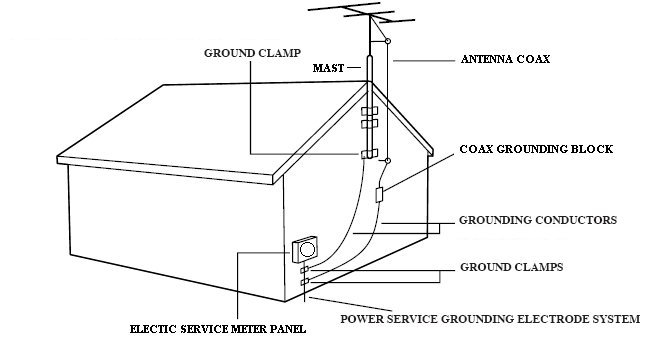
Grounding an antenna isn’t difficult to accomplish yourself, but it shouldn’t be too expensive to have a professional come out and do this for you. If you want to attempt this, below are the steps I took to recreate what is essentially depicted in the diagram.
1. Locate your house service ground wire
In the diagram, the house ground wire is labeled as the “Power System Grounding Electrode.” You will typically find this wire near your electric meter or where power service enters your house. This is typically near your breaker panel, but on the outside of the house. It should be a thick gauge copper wire coming out of the ground. Here is a photo of what mine looks like.
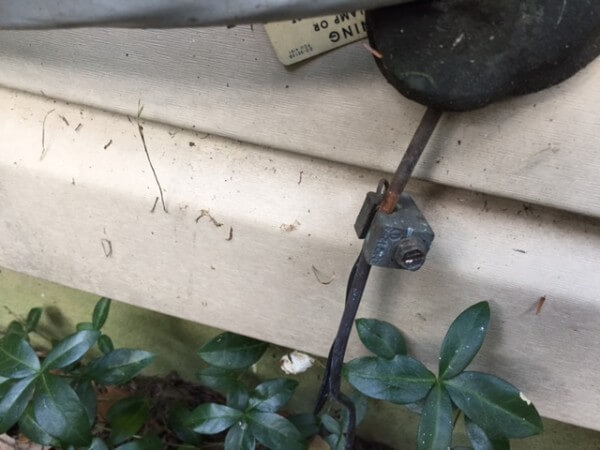
The preferred way to ground an antenna is by using your house service ground.
2. Connect the ground wire to the house ground
Notice the clamp on the ground wire in the picture above? Here is a close up picture of what it looks like.
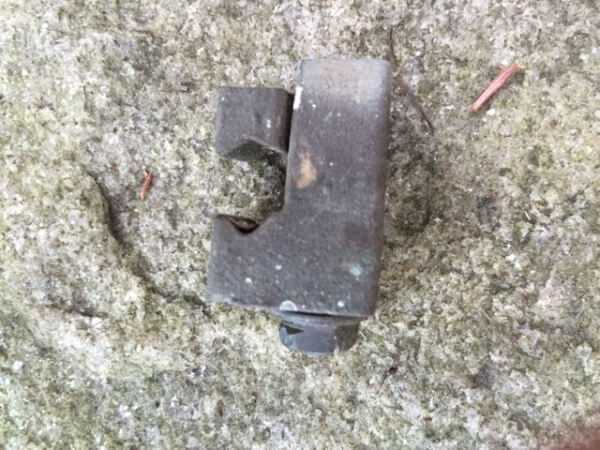
Use a solid copper wire and use the ground clamp to connect it to the house service ground. The minimum size wire you should use to connect the antenna to the house service ground is 10 AWG (American Wire Gauge ), which is 1/10th of an inch in diameter.
The type of clamp connector will depend on the size of your ground wire. The house ground wire is required to be at least 2 AWG. This is about 1/4 inch in diameter.
Use this table to get an idea of the AWG of your ground wire and then you can buy a clamp that will connect the antenna ground wire to your house ground wire. You can use any size wire for your antenna ground as long as it’s larger than 10 AWG (and smaller than your house ground.
You want to be sure to get a solid copper wire, as stranded wire can become brittle over time. I personally used a 6 AWG solid copper wire and clamped it to my house ground wire as seen in the picture below.
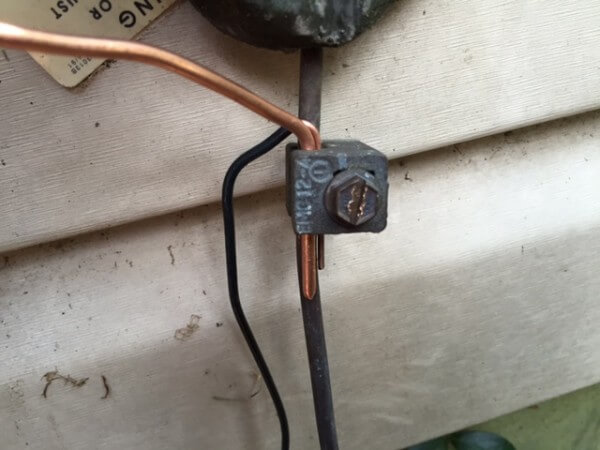
3. Connect the Antenna to Ground
To connect the antenna to ground, simply connect the other end of your ground wire to coaxial grounding block. The block will have two female coaxial connectors and a slot to connect your ground wire. The picture below illustrates what this looks like.
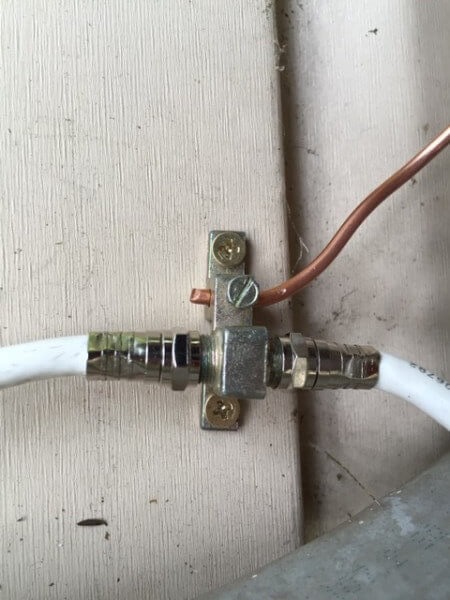
The left coaxial connector connects to my antenna on the roof, while the right coaxial enters my house and goes to my digital tuner. Your coaxial is now grounded. Be sure to check your channels on your television to ensure they still are being received. If done properly, there should be little noise added to the system. In fact, after grounding the antenna I actually gained 1 channel. However, that could have just been a coincidence.
If the antenna is already installed and there is no coaxial joint that can be unscrewed to connect the block, don’t worry. I explain what to do at the end of the post.
Update: It’s been pointed out that I should use compression fittings to avoid water seepage into the line. Furthermore, make sure the cables are connected horizontally at the block to avoid water traveling down the cable and into the connection.
4. Ground the Antenna Mast
Grounding the coaxial was the hard part. Grounding the mast is easy. Simply attach an 8 or 10 AWG copper wire to the mast using a mast ground clamp and run the other end of the copper wire to the house ground. It’s recommended to use a separate clamp, and not the one used to ground the coaxial to the house ground.
You can see the black mast ground wire in the picture at the end of step 2. As you can see, I need to purchase a second clamp.
Congratulations! Your antenna is fully grounded.
Maybe you will like:
FTA-2 UHF Two Panel Directional TV Antenna
FTA-3 TV PANEL ANTENNA 2 LAYERS 4 SIDES DVB-T UHF Base Antenna

